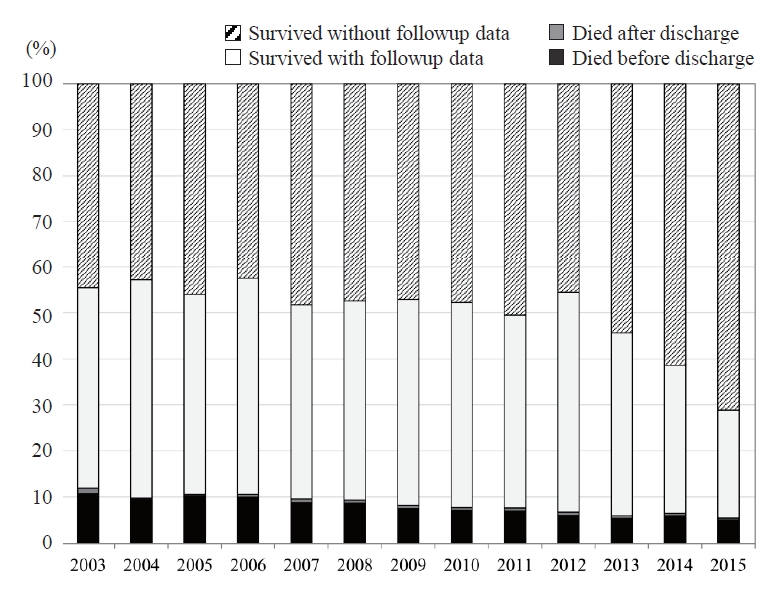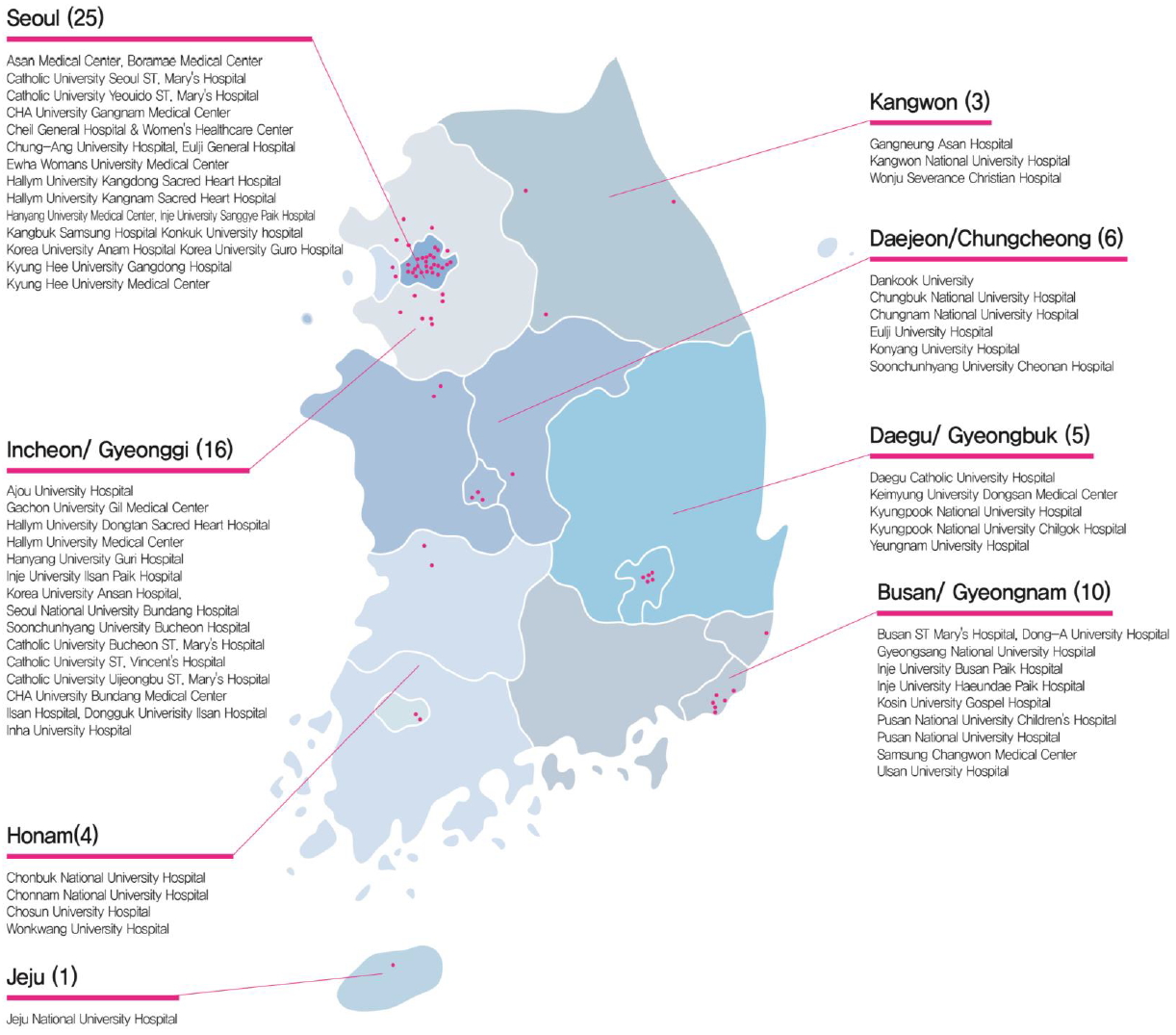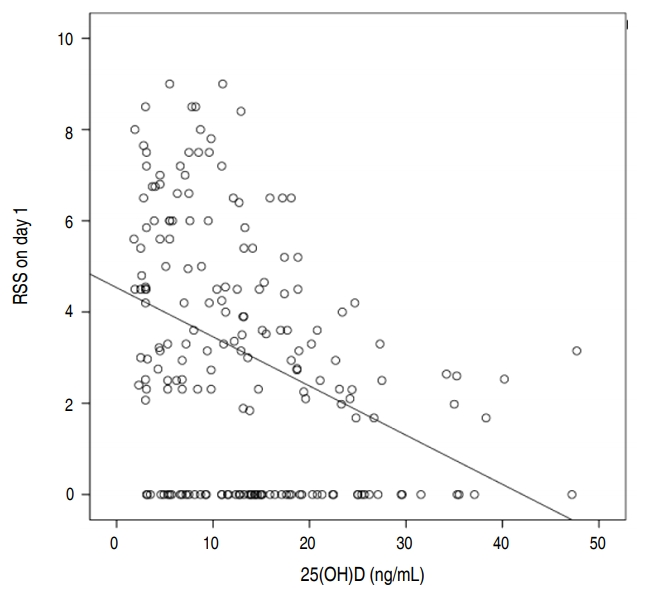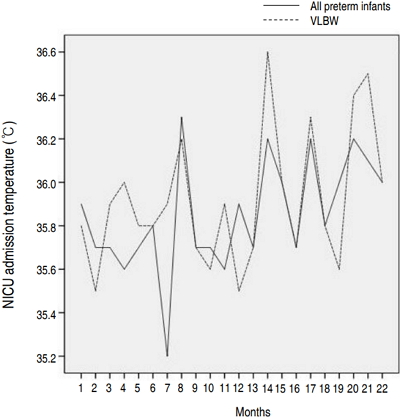Search
- Page Path
-
- HOME
- Search
- Review Article
- Neonatology (Perinatology)
- Neurodevelopmental outcomes of very low birth weight infants in the Neonatal Research Network of Japan: importance of neonatal intensive care unit graduate follow-up
- Yumi Kono; on behalf of the Neonatal Research Network of Japan
- Clin Exp Pediatr. 2021;64(7):313-321. Published online November 9, 2020
-

· Very low birth weight infants remain at high risk of developing neurodevelopmental impairments in early childhood.
· It is important to establish a network follow-up protocol and complete assessments with fewer dropouts to enable clarification of the outcomes of registered infants.
· All possible strategies should be employed to maintain good compliance after neonatal intensive care unit discharge.
- Short- and long-term outcomes of very low birth weight infants in Korea: Korean Neonatal Network update in 2019
- Jang Hoon Lee, YoungAh Youn, Yun Sil Chang; Korean Neonatal Network
- Clin Exp Pediatr. 2020;63(8):284-290. Published online February 5, 2020
-

The Korean Neonatal Network (KNN) has collected population-based data for very low birth weight infants (VLBWIs) born in Korea since 2013. The survival rate of all VLBWIs was 86% in Korea. The overall prevalence of cerebral palsy was 6.2%–6.6%. Bilateral blindness and hearing loss were reported in 0.2%–0.3%, 0.8%–1.9%, respectively. The KNN has published annual reports and papers for facilitating the improvement of VLBWIs outcome in Korea.
- Original Article
- Neonatology (Perinatology)
- Association between vitamin D level at birth and respiratory morbidities in very-low-birth-weight infants
- Ian Kim, Sung Shin Kim, Jee In Song, Seock Hwa Yoon, Ga Young Park, Yong-Wha Lee
- Clin Exp Pediatr. 2019;62(5):166-172. Published online October 24, 2018
-

Purpose: This study aimed to evaluate vitamin D status at birth in very-low-birth-weight infants (VLBWIs: <1,500 g) and to determine the association between vitamin D level and respiratory morbidity. Methods: A retrospective study was conducted at Soonchunhyang University Bucheon Hospital between November 2013 and November 2017. We collected blood samples and data on respiratory morbidity from 230 VLBWIs on the first...
- The impact of a quality improvement effort in reducing admission hypothermia in preterm infants following delivery
- Han Saem Choi, Soon Min Lee, Hoseon Eun, Minsoo Park, Kook-In Park, Ran Namgung
- Clin Exp Pediatr. 2018;61(8):239-244. Published online August 15, 2018
-

Purpose: Hypothermia at admission is associated with increased mortality and morbidity in preterm infants. We performed a quality improvement (QI) effort to determine the impact of a decrease in admission hypothermia in preterm infants. Methods: The study enrolled very low birth weight (VLBW) infants born at Gangnam Severance Hospital between January 2013 and December 2016. This multidisciplinary QI effort included the...
- Analysis of the association between necrotizing enterocolitis and transfusion of red blood cell in very low birth weight preterm infants
- Seon-Yeong Bak, Sihyoung Lee, Jae-Hong Park, Kyu-Hee Park, Ji-Hyun Jeon
- Clin Exp Pediatr. 2013;56(3):112-115. Published online March 18, 2013
-
Purpose To investigate the association between necrotizing enterocolitis (NEC) and red blood cell transfusions in very low birth weight (VLBW) preterm infants.
Methods We studied were 180 VLBW preterm infants who were admitted to the neonatal intensive care unit of CHA Gangnam Hospital from January of 2006 to December of 2009. The subjects were divided into 2 groups: an NEC group (greater than...
- Outcomes of small for gestational age micropremies depending on how young or how small they are
- Hee Joon Yu, Eun Sun Kim, Jin Kyu Kim, Hye Soo Yoo, So Yoon Ahn, Yun Sil Chang, Won Soon Park
- Clin Exp Pediatr. 2011;54(6):246-252. Published online June 30, 2011
-
Purpose The outcomes of small for gestational age (SGA) infants especially in extremely low birth weight infants (ELBWIs) are controversial. This study evaluated the mortality and morbidity of ELBWIs, focusing on whether or not they were also SGA.
Methods The medical records of 415 ELBWIs (birth weight <1,000 g), who were inborn and admitted to the Samsung Medical Center neonatal intensive care unit...
- Growth and clinical efficacy of fortified human milk and premature formula on very low birth weight infants
- Heewon Chueh, Myo Jing Kim, Young-A Lee, Jin-A Jung
- Clin Exp Pediatr. 2008;51(7):704-712. Published online July 15, 2008
-
Purpose : A prospective, controlled trial was conducted to evaluate growth, efficacy, safety and nutritional status for very low birth weight infants fed with human milk fortified with Maeil human milk fortifier (Maeil HMF ; Maeil Dairies Co., Ltd.). Methods : We enrolled 45 premature infants with a birth weight <1,500 g and gestational age <33 weeks, who were born at... -
- Review Article
- Changes in birth rates of low birth weight and premature infants in Korea over the past 7 years
- Min Hee Kim
- Clin Exp Pediatr. 2008;51(3):233-236. Published online March 15, 2008
-
In recent years, Korea has experienced a steadily declining birth rate, which is a serious social problem in the country. Although living conditions have improved, the birth rates for low birth weight infants and preterm babies has increased because more and more women choose to give birth later in life and the social environment has changed. The rise in low... -
- Original Article
- Platelet count and mean platelet volume in low birth weight infants (≤2,000 g) with sepsis
- Wan-soo Lee, Jin-young Cho, Seung-taek Yoo, Chang-woo Lee, Doo-young Choi, Jong-duck Kim, Yeon-kyun Oh
- Clin Exp Pediatr. 2007;50(7):643-648. Published online July 15, 2007
-
Purpose : Sepsis is a common complication in Neonatal Intensive Care Units (NICU), seen especially in low birth weight (LBW) infants. A recent study showed that fungal or gram-negative sepsis is associated with a greater degree of thrombocytopenia than is seen with gram-positive sepsis. So, this study was undertaken to examine the platelet counts and platelet indices in LBW infants... -
- Fluconazole prophylaxis in high-risk, very low birth weight infants
- Soo Young Kim, Soon Joo Lee, Mi Jeong Kim, Eun Song Song, Young Youn Choi
- Clin Exp Pediatr. 2007;50(7):636-642. Published online July 15, 2007
-
Purpose : Fluconazole prophylaxis for very low birth weight (VLBW) infants has been shown to reduce invasive fungal infection and its mortality. This study aims to evaluate the effect of fluconazole prophylaxis in VLBW infants on the incidence and mortality of fungal infection. Methods : VLBW infants with endotracheal intubation and central vascular access admitted to the Neonatal Intensive Care... -
- Immune responses of hepatitis B vaccination among very low birth weight infant
- Young-Deuk Kim, Myung-Ki Han, Ai-Rhan E. Kim, Ki-Soo Kim, Soo-Young Pi
- Clin Exp Pediatr. 2006;49(8):857-863. Published online August 15, 2006
-
Purpose : To evaluate the immunogenicity of hepatitis B vaccine among very low birth weight infants(VLBWI) who were vaccinated at 0, 1, 6 months of chronological age and to determine the factors associated with antibody formations. Methods : A total of 243 VLBWI admitted to Seoul and Gangneung Asan Medical Center neonatal intensive care units from 1997 to 2004 were... -
- Survival Rate in Very Low Birth Weight Infants
- Jae Ju Cho, Soon Bum Lee, Woo Sung Park, Young Pyo Chang
- Clin Exp Pediatr. 2004;47(5):505-509. Published online May 15, 2004
-
Purpose : We observed changes in the outcome of very low birth weight infants(VLBWI) admitted to the neonatal intensive care unit(NICU) of Dankook University Hospital(DKUH) in the last six years. Methods : The distribution of birth weight and gestational age, survival rate, neonatal complications, and causes of death for 228 VLBWI who had been admitted to DKUH from 1st January... -
- The Effect of Parenteral Nutrition and Respiratory Distress Syndrome in the Early Neonatal Period on Bone Mineralization at the Time of Reaching 2 kg Body Weight in Premature Infants
- Yun-Jin Lee, Su-Eun Park, Jae-Hong Park
- Clin Exp Pediatr. 2004;47(4):368-372. Published online April 15, 2004
-
Purpose : To evaluate the effect of parenteral nutrition in early neonatal period on bone mineralization at the time of reaching 2 kg body weight in premature infants, bone mineral density(BMD) in infants who received long-term parenteral nutrition in the early neonatal period was measured and compared with infants who received enteral nutrition only. Methods : Twenty low birth weight infants(those... -
- Risk Factors of Nephrocalcinosis in Very Low Birth Weight(VLBW) Infants
- Gyu Hong Shim, Jin A Lee, Yun Jung Shin, Ee Kyung Kim, June Dong Park, Beyong Il Kim, Jung Hwan Choi
- Clin Exp Pediatr. 2004;47(3):275-281. Published online March 15, 2004
-
Purpose : Nephrocalcinosis in very low birth weight(VLBW) infants were known to be caused by a longer duration of furosemide use. However, etiologies, pathogenesis and risk factors remain unclear. Therefore, we examined the incidence and risk factors of nephrocalcinosis in VLBW infants retrospectively. Methods : Inborn babies of birth weights less than 1,500 gm were examined retrospectively. Data were reviewed on... -
- Comparison of Rehospitalization during the First Year of Life in Normal and Low Birth Weight Infants Discharged from NICU
- Sae Ah Min, Myung Won Jeon, Sun Hee Yu, Oh Kyung Lee
- Clin Exp Pediatr. 2002;45(12):1503-1511. Published online December 15, 2002
-
Purpose : Although the short- and long-term outcomes of low birth weight(LBW) neonatal intensive care unit(NICU) survivors have been extensively studied, much less information is available for normal birth weight(NBW) infants(greater than 2,500 gm) who require NICU care. Methods : We retrospectively examined the neonatal hospitalizations and one year health status of 302 NBW and 131 LBW admissions to our... -
- A Clinical Characteristics of Systemic Candidiasis in Neonatal Intensive Care Unit : Comparison with Systemic Bacterial Infection
- Jung Hwa Lim, Kyung Pil Park, Jin Kyung Kim, Heng Mi Kim
- Clin Exp Pediatr. 2002;45(7):847-854. Published online July 15, 2002
-
Purpose : Long term hospitalized infants in neonatal intensive care units(NICUs) are prone to systemic infection. It is important to differentiate systemic candidiasis from systemic bacterial infection early in the course. Thus, in this study, we have compared clinical characteristics of systemic candidiasis and systemic bacterial infection, in premature low birth weight infants. Methods : Retrospective chart review of the medical... -
- Influence of Phototherapy on Incidence of Patent Ductus Arteriosus in Very Low Birth W eight Infants
- Hee Seok Kim, Ee Kyung Kim, Yun Kyoung Lee, Hee Eun Lee, Chan Hwu Park, Kyung Ran Park, Jun Dong Park, Beyong Il Kim, Woong Heum Kim, Jung-Hwan Choi, Yong Su Yun, Chong Ku Yun, Jeong Mi Lee
- Clin Exp Pediatr. 1997;40(10):1410-1418. Published online October 15, 1997
-
Purpose : Patent ductus arteriosus(PDA) is a common disease in very low birth weight infants(VLBWI). Hemodynamically significant PDA increases the morbidity and mortality of premature infants. Based on experimental model, light inhibits the constriction of immature piglet' s ductal rings. No specific mechanism adequately explains the effect of light on the relaxation of PDA. Several hypotheses, including activation of photosensitive metabolites, alterations in receptors, or... -
- Growth and Neurodevelopmental Outcome on Very Low Birth Weight Infants During 2 Years
- Eun Suk Kim, Jong Uk Kim, Oh Kyung Lee, Wan Soeb Kim
- Clin Exp Pediatr. 1996;39(5):641-651. Published online May 15, 1996
-
Purpose : By rapid development of neonatal intensive care from 1960, we are able to expect the long survival of the very low birth weight infants. But, there were high risk of poor growth, neurodevelopmental delay, deafness, and blindness in very low birth weight infants. So, it is important to follow-up after discharge. We try to compare normal term infants with... -
- Clinical Observation for Low Birth Weight Infants
- Hye Jin Lee, Soon Wan Kwon, Soon Ok Byun, Ji Sub Oh
- Clin Exp Pediatr. 1993;36(7):928-935. Published online July 15, 1993
-
Clinical observations were made on 338 low birth weight infants, who were delivered at Pusan Wallace Memorial Baptist Hospital, during the 3 year periods from 1989 to 1991. The results were as follows; 1) The incidence of LBWI was 5.6% and sex ratio was 1:1.09. Among them AGA was 62.7%. 2) Of all infants, 47.3% were in the birth weight range of 2251-2500... -
- Neurosonographic Diagnosis of Periventricular-Intaventricular Hemorrhage in Low Birth Weiht Infants
- Hee Seok Koh, Dong Kyun Ryu, Young Tack Jang, Oh Kyung Lee, Jin Ok Choi
- Clin Exp Pediatr. 1993;36(1):57-66. Published online January 15, 1993
-
Periventricular-intraventricular hemorrhage (PV-IVH) is one of the most important neurologic lesion of the low birth weight infants. Serial neurosonographic examinations were performed in 113 low birth weight infants who were admitted to the neonatal internsive care unit of Presbyterian Medical Center from November 1, 1990 to July 31, 1991. The results were summarized as follows: 1) The incidence of PV-IVH in he study... -
- Clinical and statistical observation for very low birth weight infants.
- Sung Shin Park, Ji Hee Jung, Dong Hwan Lee, Sang Jhoo Lee
- Clin Exp Pediatr. 1991;34(12):1629-1640. Published online December 31, 1991
-
We made clinical and statistical observation of 90 very low birth weight infants who were admitted at Soonchunhyang university hospital during the 6 years period from January 1985 through December 1990. The result obtained were as follows: 1) The incidence of very low birth weight infant during 6 years period was 0.68%, and the mortality rate was 488/1000 very low birth weight infants. 2) There was no obvious... -
- Neurosonographic Follow-up Study in Low Weight Infants.
- Yil Sub Lee, Chul Lee, Ran Namgung, Dong Gwan Han, Ki Keun Oh
- Clin Exp Pediatr. 1988;31(12):1573-1579. Published online December 31, 1988
-
Serial neurosonographic examinations were performed in 34 low birth weight infants who were admitted to the neonatal intensive care unit of Yong-Dong Severance Hospital. Among them, 14 (41 %)were found to have periventicular-intraventricular hemorrhage. The initial hemorrhage occured in the first three days of life among 71% infants. After initial hemorrhage, hemorrhage was decreased in size and thereafter absorbed. Fourteen (44%) infants demonsrated cysts... -
- Clinical Survey of Very low Birth Weight Infant.
- Seong Sook Jeon, Wha Mo Lee, Yang Sook Choi, Son Sang Seo
- Clin Exp Pediatr. 1988;31(9):1120-1125. Published online September 30, 1988
-
A clinical survey of Very Low Brith Weight Infant was done on 27,170 infants bom at II Sin Christian Hospital between Jan. 1 1983 and Dec. 31 1986. The results were as follows; 1) The incidence of VLBWI in the 27,170 births was 1.0%, and there was no annual variation. 2) Among 10,749 multiparaty there was a higher incidence of VLBWI (1.4%) compared to that in primiparity... -
- The Effect of Blue Light and White Light, Continous and Intermittent Phototherapy in the Treatment of Jaundice for the Low Birth Weight Infants.
- Ki Tae Kim, Heon Kyung Lee, Woo Yeong Chung, Soon Youg Lee, Yeon Soon Kim
- Clin Exp Pediatr. 1983;26(4):299-303. Published online April 30, 1983
-
The effect of phototherapy was studied between blue and white lights, and continuous and intermittent regimens in the treatment of jaundice for the low birth weights at Busan Children’s Hospital from October, 1981 to March, 1982. The results were as following: 1) The duration of phototherapy necessary to reduce serum bilirubin level below 8 mg/dl were 58.9 hours with blue light, and 102.3 hours with white... -
- Clinical study of low birth weight infants.
- Sung Ho Chang, Young Gun Kim, Cook Huh, Baek Keun Lim, Jong Soo Kim
- Clin Exp Pediatr. 1982;25(9):898-905. Published online September 30, 1982
-
A Clinical Study was made on. 542 low birth weight infants, admitted to the department of pediatrics, Wonju Christian Hospital during 6 years from 1975 to 1980. The results were as follows: 1) Incidence of low birth weight infants was 12.8% without sexual and seasonal predo- migance, of which small for gestational age infants were about 50%. 2) Low birth weight infants were most prevalent among mothers... -
- Clinical and Statistical Observation for Low Birth Weight Infants.
- Sung Ho Chun, Seung Woo Moon, So Kyung Park, Jung Ju Kim, Dong Hag Shin
- Clin Exp Pediatr. 1982;25(5):429-435. Published online May 31, 1982
-
We made clinical and statistical observation of low birth weight infants who were delivered at Keimyung University hospital during the 2 years and 4 months period from March, 1979 through July, 1981. The results obtained were as follows: 1) The sex ratio for live birth infants, male to female, was 1.28:1, and low-birth-weight infants was 0.96:1. The incidence of low... -
- Clinical and Statistical Observation for Low Birth Weight Infants.
- Chong Ok Lee, Eun Hee Koh, Sang Man Sin, Sang Jhoo Lee
- Clin Exp Pediatr. 1981;24(12):1142-1148. Published online December 15, 1981
-
A clinical and statistical observation was made on 383 low birth weight infants, delivered at Soon Chun Hyang hospital from Jan. 1st 1975 to May 31st 1980. The results were as follows: 1)Incidence of low birth weight infants was 5. 3% without sexual predominence, of which twin births were 13.3%, prematures were 78.3%, SGA were 26%. 2) Maternal predisposing factors of low... -
-

-
-

-

-
Impact Factor4.2
-
6.52022CiteScore92nd percentilePowered by







